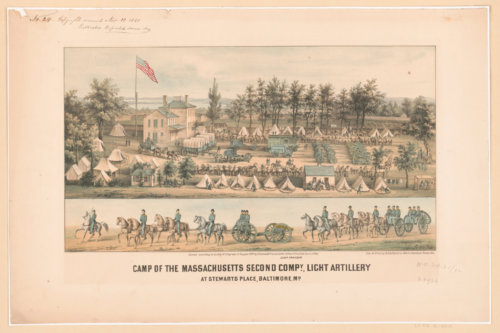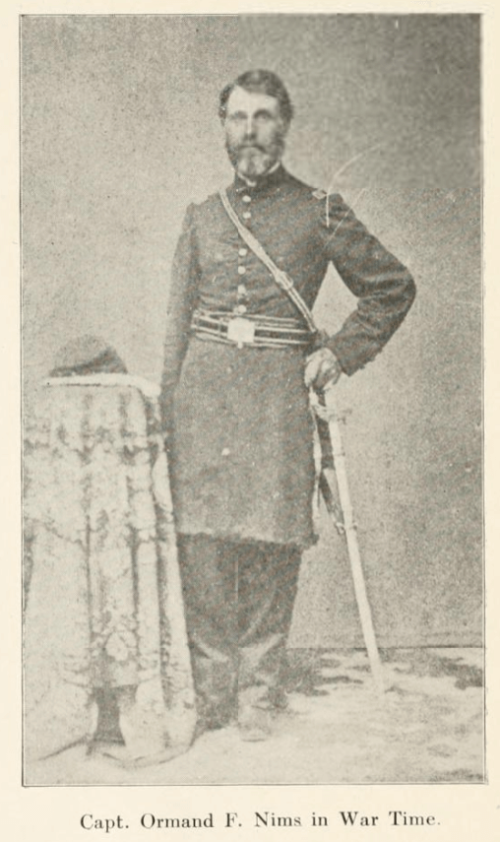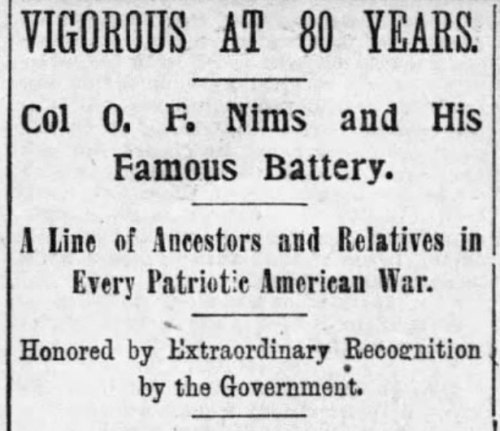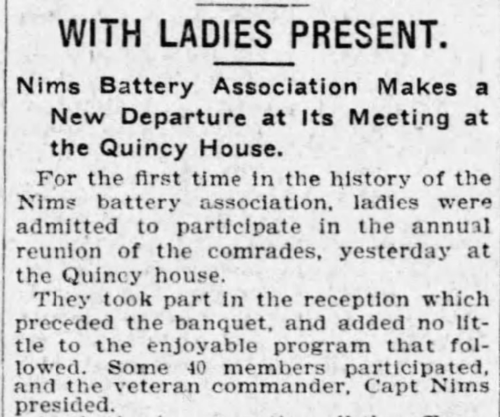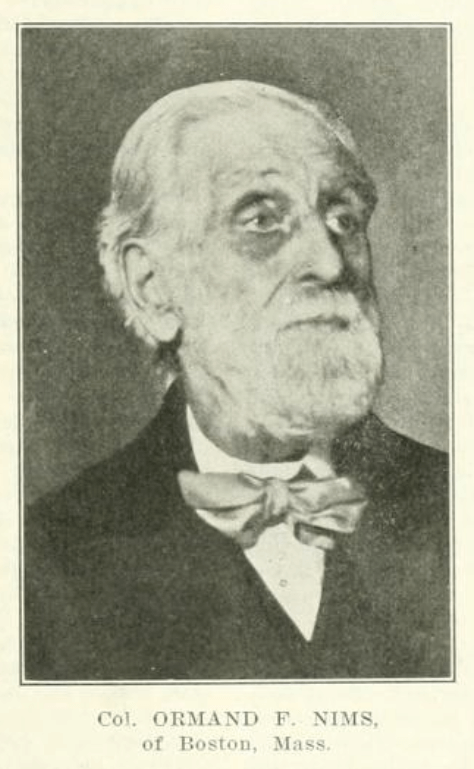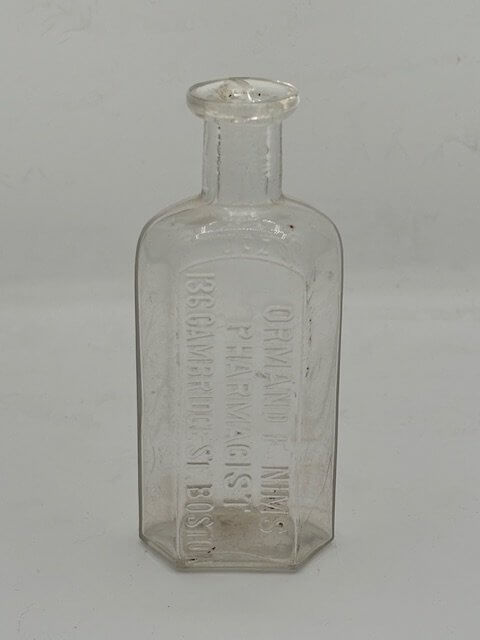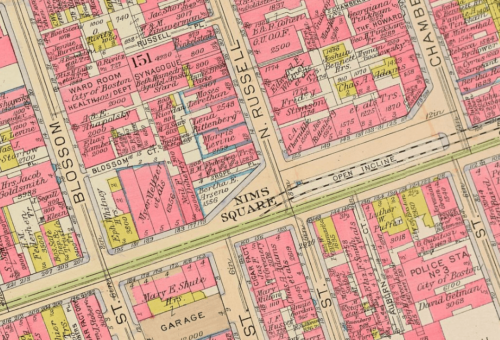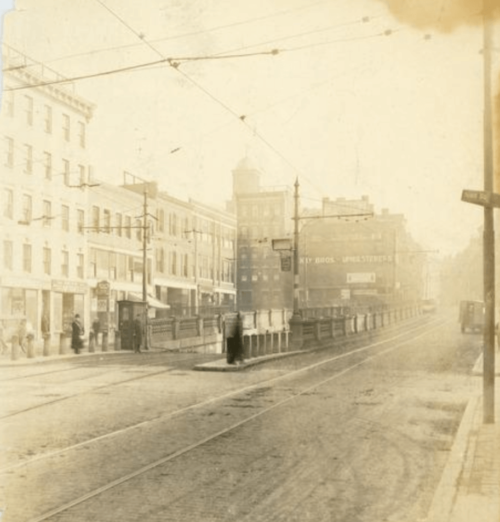Ormand F. Nims
In 1916, Boston’s Committee on Public Lands voted in favor of naming the junction at Cambridge, North Russell, and South Russell Streets “Nims Square,” in honor of Ormand F. Nims, a distinguished Civil War veteran and longtime West End business owner.
Ormand F. Nims was born on his family’s farm in Sullivan, N. H. on August 30, 1819. Influenced by his family’s long military history, he joined the Sullivan Militia when he was fifteen. When Ormand was 23, he moved to Boston and, in 1854, he bought a drug store on Cambridge St. While running his business he served in a militia, the Boston Light Artillery, under the command of Capt. Moses G. Cobb. He was made fourth lieutenant and later received command of the battery.
On April 19, 1861, Governor Andrews ordered the formation of the Second Massachusetts Battery, an artillery battery to serve in the Union army, and designated Major Moses Cobb as its commander. Recruiting headquarters were opened on the 20th of April at the Boston Light Artillery Armory under Nims and, in less than two days, over two hundred men had applied for enlistment. By July, Ormand was placed in command of the new battery and the Second Massachusetts Light Artillery became known as Nims’ Battery. The battery, which trained at Camp Adams in Quincy, Massachusetts, was the first unit of artillery to be recruited in Massachusetts for a three-year service term in the Civil War. The battery served near Baltimore and then moved to Vicksburg and the Gulf Coast.
In 1865, by special enactment of the Senate, Nims received the titles of “Brevet Major—Brevet Lieutenant—Colonel—and Brevet Colonel, for gallant and meritorious service during the war.” At the close of the Civil War, the Boston Transcript reflected: “It is a remarkable fact that during the three and a half years that Captain Nims commanded the 2d Battery, punishment was to its members almost unknown. Splendid discipline was maintained solely by esprit de corps and by the respect and affection entertained for the commander on one hand and by the fatherly care and solicitude always exhibited by Captain Nims for his men under all circumstances.”
After the war, Ormand returned to his drug store on Cambridge Street. With the closest pharmacy to Massachusetts General Hospital, he became known as the druggist who would not turn customers away who could not pay. He made it a practice to give away at least one prescription a day. Ormand married and had two daughters, but his wife died at a young age.
The Nims Battery Association held monthly meetings at 80 Cambridge Street. In 1888, the Nims’ Battery Ladies’ Social Club was organized. It was described as: “the mothers, wives, and daughters or indeed any relative of the men of the battery and its purpose is not solely social but mutually helpful as well. It aims to visit the sick among the members, to give material aid if necessary and in any way possible assist the organization to which it is auxiliary.”
A trusted neighbor and friend, Ormand worked in his drug store at 136 Cambridge Street until the age of ninety. In 1909, a reporter from The Pharmaceutical Era visited his pharmacy, describing it as quaint and old-fashioned, with no soda fountains or cigars allowed inside. The reporter found the 89-year-old Nims (“the oldest druggist in Massachusetts”) to be vigorous despite his age. Indeed, he was spotted removing a splinter from the eye of a man without the aid of spectacles. Nims would open the pharmacy himself at 7am and keep it running til 11pm.
Colonel Nims died at his home, 42 Blossom Street, on May 23, 1911, at the age of 91. In 1916, Boston’s Committee on Public Lands voted in favor of naming the open space at the junction of Cambridge, North Russell, and South Russell Streets “Nims Square.” The space was also the location of the Cambridge St. incline to the East Boston tunnel, which would see great change over the coming years.
Article by Janelle Smart Fisher, edited by Grace Clipson.
Source: Caroline E. Whitcomb, History of the Second Massachusetts Battery of Light Artillery (Nims’ Battery): 1861-1865, compiled from records of the Rebellion, official reports, diaries and rosters; City of Boston Archives; Boston Globe, August 27, 1899; Boston Globe, February 23, 1904; Boston Globe, May 23, 1911; Boston Globe, August 12,1914; Boston Globe, March 5, 1916; The Pharmaceutical Era, Volume 41, D. O. Haynes & Company, 1909.


